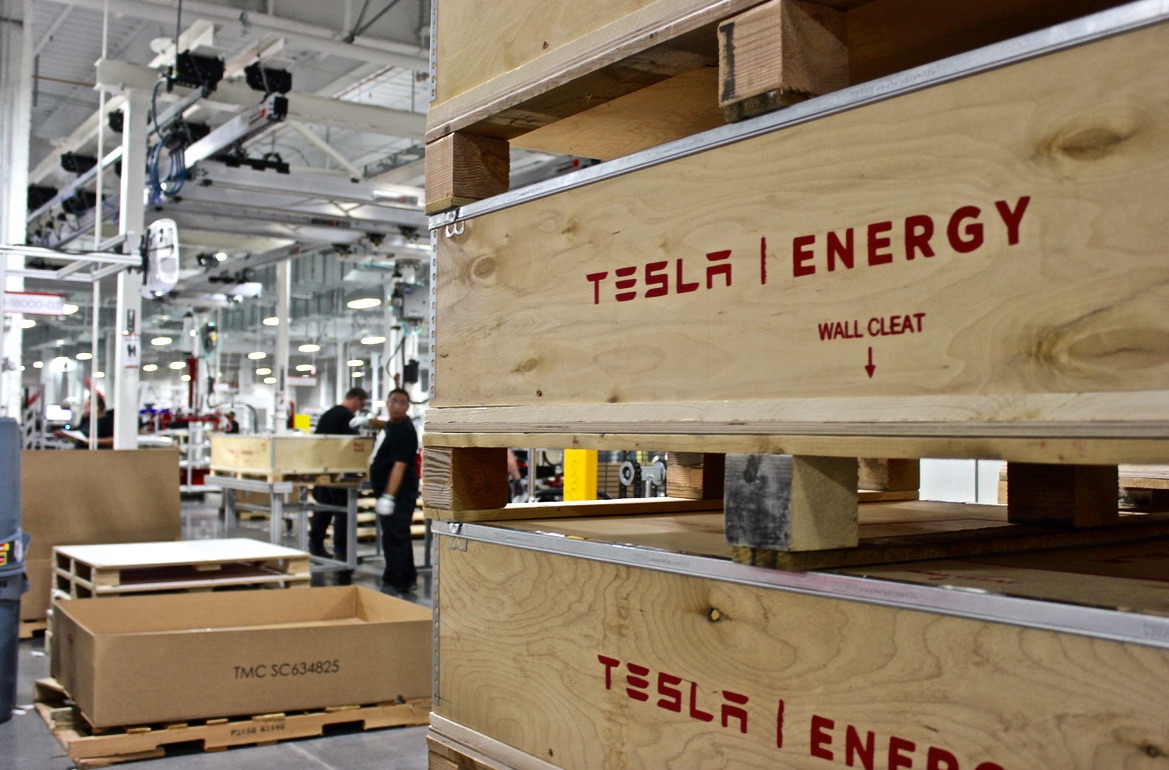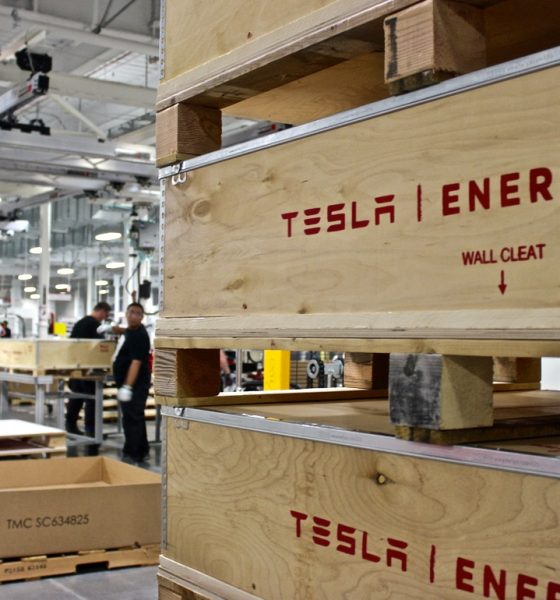

News
Tesla “Battery Day” event date is looking like April 2020, says Elon Musk
Tesla CEO Elon Musk said the company is preparing to host a Battery Day for shareholders sometime after the first quarter, possibly in April. The announcement came during the earnings call following Tesla’s release of its Q4 2019 Update Letter.
Responding to a question from a participating investor about where Tesla stands in growing its battery capacity, Musk said that the company has already demonstrated massive improvement in growing the capacity of the cells, modules, and batteries it uses for its all-electric vehicles.
The CEO attributed part of the improvements to Tesla’s relationships with various battery partners, such as Panasonic, which is Tesla’s in-house supplier of lithium-ion batteries at Giga Nevada. Tesla also teamed up with other partners such as LG and CATL to produce battery packs for its cars produced in China. Aside from that, Musk declined to provide additional details on future plans for improving its battery technology, leaving investors to look forward to the upcoming Battery Day event later this year.
“We have a lot more to talk about this in detail in Battery Day probably April. We have a very compelling strategy. I mean, we are super deep in cell. Super deep. Cell through battery,” he said.
Tesla’s efforts to upgrade its batteries include the acquisition of California-based energy storage firm Maxwell Technologies, which was completed in May last year. Tesla’s interest in Maxwell primarily lies in the latter’s innovations in ultracapacitors and dry electrode technologies, which could potentially improve the company’s batteries.
Prior to the acquisition, Tesla also submitted a patent for an idea to use electrolyte additives to improve the performance and lengthen the lifespan of lithium-ion cells. The patent, titled “Dioxazolones and Nitrile Sulfites as Electrolyte Additives for Lithium-ion Batteries,” provided details on how Tesla can significantly increase the lifespan and performance of its batteries by adding electrolyte additives such as lithium salt. Tesla also submitted another patent for using cold plates and heat pipes to reduce heat generated by the battery, thereby increasing the longevity of its energy storage systems.
The latest developments appear to be moving Tesla toward the completion of a 1-million mile battery. In April last year, Musk said that Tesla owners will soon be able to drive their cars for up to 1 million miles over the lifespan of their vehicles. This is equivalent to 20 years if the cells are used for energy storage systems. Tesla lead researcher Jeff Dahn and a team from the Dalhousie University physics and atmospheric science department have also developed pouch cells that can last 1 million miles or 20 years in a grid storage system.
Tesla’s huge lead in the electric vehicle market is due in part to its constant efforts to improve its battery technology. In fact, its batteries have improved so much over the years that the Model S is nearing a range of 400 miles. The published range for the luxury sedan is 373 miles, but Musk said during the earnings call that the actual range is somewhere in the 380s.
“S and X actually have more range than we are currently stating on the website. We just haven’t gotten around to updating the EPA […] number, but the actual range of the Model S and X are above what the website says they are,” he said. “Somewhere in the 380s, something like that.”
He also added that the 18650 lithium-ion cells that power the Model S and X have largely improved over the years, adding that further developments could raise the range of the Model S to 400 miles.
“I think we’re pretty happy with the energy content of the cell and the improvements in the efficiency of the vehicle,” he said. “We’re rapidly approaching a 400-mile range for the Model S, for example.”
Battery Day is expected to be similar to Autonomy Day, which was held in April last year. The event, which was attended by investors and also available via livestream, was a full three-hour technical discussion of Tesla’s work on autonomous driving technology and how the company plans to achieve its goal of delivering fully self-driving cars.

News
Tesla FSD fleet is nearing 7 billion total miles, including 2.5 billion city miles
As can be seen on Tesla’s official FSD webpage, vehicles equipped with the system have now navigated over 6.99 billion miles.

Tesla’s Full Self-Driving (Supervised) fleet is closing in on almost 7 billion total miles driven, as per data posted by the company on its official FSD webpage.
These figures hint at the massive scale of data fueling Tesla’s rapid FSD improvements, which have been quite notable as of late.
FSD mileage milestones
As can be seen on Tesla’s official FSD webpage, vehicles equipped with the system have now navigated over 6.99 billion miles. Tesla owner and avid FSD tester Whole Mars Catalog also shared a screenshot indicating that from the nearly 7 billion miles traveled by the FSD fleet, more than 2.5 billion miles were driven inside cities.
City miles are particularly valuable for complex urban scenarios like unprotected turns, pedestrian interactions, and traffic lights. This is also the difference-maker for FSD, as only complex solutions, such as Waymo’s self-driving taxis, operate similarly on inner-city streets. And even then, incidents such as the San Francisco blackouts have proven challenging for sensor-rich vehicles like Waymos.
Tesla’s data edge
Tesla has a number of advantages in the autonomous vehicle sector, one of which is the size of its fleet and the number of vehicles training FSD on real-world roads. Tesla’s nearly 7 billion FSD miles then allow the company to roll out updates that make its vehicles behave like they are being driven by experienced drivers, even if they are operating on their own.
So notable are Tesla’s improvements to FSD that NVIDIA Director of Robotics Jim Fan, after experiencing FSD v14, noted that the system is the first AI that passes what he described as a “Physical Turing Test.”
“Despite knowing exactly how robot learning works, I still find it magical watching the steering wheel turn by itself. First it feels surreal, next it becomes routine. Then, like the smartphone, taking it away actively hurts. This is how humanity gets rewired and glued to god-like technologies,” Fan wrote in a post on X.
News
Tesla starts showing how FSD will change lives in Europe
Local officials tested the system on narrow country roads and were impressed by FSD’s smooth, human-like driving, with some calling the service a game-changer for everyday life in areas that are far from urban centers.

Tesla has launched Europe’s first public shuttle service using Full Self-Driving (Supervised) in the rural Eifelkreis Bitburg-Prüm region of Germany, demonstrating how the technology can restore independence and mobility for people who struggle with limited transport options.
Local officials tested the system on narrow country roads and were impressed by FSD’s smooth, human-like driving, with some calling the service a game-changer for everyday life in areas that are far from urban centers.
Officials see real impact on rural residents
Arzfeld Mayor Johannes Kuhl and District Administrator Andreas Kruppert personally tested the Tesla shuttle service. This allowed them to see just how well FSD navigated winding lanes and rural roads confidently. Kruppert said, “Autonomous driving sounds like science fiction to many, but we simply see here that it works totally well in rural regions too.” Kuhl, for his part, also noted that FSD “feels like a very experienced driver.”
The pilot complements the area’s “Citizen Bus” program, which provides on-demand rides for elderly residents who can no longer drive themselves. Tesla Europe shared a video of a demonstration of the service, highlighting how FSD gives people their freedom back, even in places where public transport is not as prevalent.
What the Ministry for Economic Affairs and Transport says
Rhineland-Palatinate’s Minister Daniela Schmitt supported the project, praising the collaboration that made this “first of its kind in Europe” possible. As per the ministry, the rural rollout for the service shows FSD’s potential beyond major cities, and it delivers tangible benefits like grocery runs, doctor visits, and social connections for isolated residents.
“Reliable and flexible mobility is especially vital in rural areas. With the launch of a shuttle service using self-driving vehicles (FSD supervised) by Tesla in the Eifelkreis Bitburg-Prüm, an innovative pilot project is now getting underway that complements local community bus services. It is the first project of its kind in Europe.
“The result is a real gain for rural mobility: greater accessibility, more flexibility and tangible benefits for everyday life. A strong signal for innovation, cooperation and future-oriented mobility beyond urban centers,” the ministry wrote in a LinkedIn post.
News
Tesla China quietly posts Robotaxi-related job listing
Tesla China is currently seeking a Low Voltage Electrical Engineer to work on circuit board design for the company’s autonomous vehicles.

Tesla has posted a new job listing in Shanghai explicitly tied to its Robotaxi program, fueling speculation that the company is preparing to launch its dedicated autonomous ride-hailing service in China.
As noted in the listing, Tesla China is currently seeking a Low Voltage Electrical Engineer to work on circuit board design for the company’s autonomous vehicles.
Robotaxi-specific role
The listing, which was shared on social media platform X by industry watcher @tslaming, suggested that Tesla China is looking to fill the role urgently. The job listing itself specifically mentions that the person hired for the role will be working on the Low Voltage Hardware team, which would design the circuit boards that would serve as the nervous system of the Robotaxi.
Key tasks for the role, as indicated in the job listing, include collaboration with PCB layout, firmware, mechanical, program management, and validation teams, among other responsibilities. The role is based in Shanghai.
China Robotaxi launch
China represents a massive potential market for robotaxis, with its dense urban centers and supportive policies in select cities. Tesla has limited permission to roll out FSD in the country, though despite this, its vehicles have been hailed as among the best in the market when it comes to autonomous features. So far, at least, it appears that China supports Tesla’s FSD and Robotaxi rollout.
This was hinted at in November, when Tesla brought the Cybercab to the 8th China International Import Expo (CIIE) in Shanghai, marking the first time that the autonomous two-seater was brought to the Asia-Pacific region. The vehicle, despite not having a release date in China, received a significant amount of interest among the event’s attendees.








